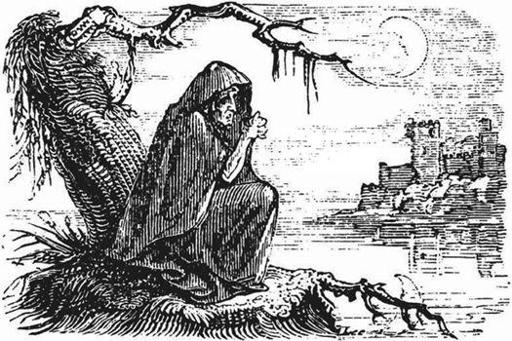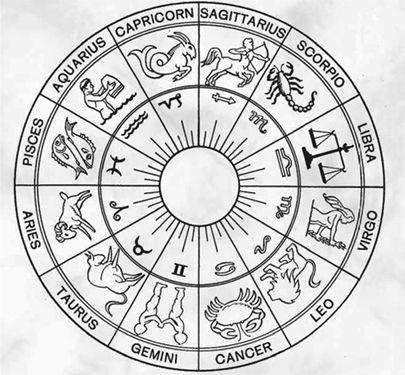The Sorcerer's Companion: A Guide to the Magical World of Harry Potter (13 page)
Read The Sorcerer's Companion: A Guide to the Magical World of Harry Potter Online
Authors: Allan Zola Kronzek,Elizabeth Kronzek
PISCES THE FISH
(February 19 to March 20): As befits the sign of the fish, Pisces are said to love water and swimming. Sensitive, receptive, emotional, imaginative, and empathetic, they are also reputed to be disorganized and impractical.
(
photo credit 3.3
)
Astrologers believe that the sun, the moon, Mercury, Venus, Mars, Jupiter, Saturn, Uranus, Neptune, and Pluto each represent a unique aspect of personality or character. These are their traditional meanings:
THE SUN
, the brightest, largest body in our solar system, represents a person’s essential personality, their core traits and general approach to life.
THE MOON
represents emotional reactions, instincts, and unconscious needs.
MERCURY
, named for the Roman messenger god, represents communication. The swiftest of the planets, it also stands for intelligence and change.
VENUS
, the brightest planet in the sky, is named for the Roman goddess of love. It symbolizes romance, relationships, love, and beauty.
MARS
, named for the Roman god of war and recognized by its reddish color, symbolizes aggression, physical energy, and the ability to take initiative.
JUPITER
, the largest planet in the solar system, represents good fortune, opportunity, and the ability to broaden one’s horizons. Jupiter was the supreme god of the Roman pantheon, the equivalent of the Greek god Zeus.
SATURN
, the slowest moving of the visible planets, represents obstructions, fears, and challenges. Saturn was a Roman god of the harvest.
URANUS
, named for the Greek sky god Ouranos, represents a person’s eccentric and rebellious side. It indicates sudden change, upheaval, and impatience.
NEPTUNE
represents imagination, creativity, dreams, and the ability to distinguish between reality and illusion. Named for the Roman god of the sea, Neptune represents things that are deep.
PLUTO
, the farthest planet from the sun, represents obsession, the unconscious mind, and the ability to transform one’s life. Pluto was the Roman equivalent of Hades, Greek god of the underworld.

 eeing a banshee is the scariest thing Harry’s classmate Seamus Finnigan can imagine. And for good reason: When one of these mournful apparitions appears before an Irishman, it means a member of his family will soon die.
eeing a banshee is the scariest thing Harry’s classmate Seamus Finnigan can imagine. And for good reason: When one of these mournful apparitions appears before an Irishman, it means a member of his family will soon die.
A fixture of Irish folklore since the eighth century, banshees are not evil creatures, but their haunting cries can make them quite terrifying. Their most distinctive physical features are their eyes, turned fiery red from centuries of weeping for those they loved and mourn. Most often described as a tall, gaunt woman with streaming white hair, the banshee usually wears a green dress covered by a gray, hooded cloak. Occasionally, however, she may appear as a small old woman or a beautiful golden-haired girl dressed in red.
Each banshee is said to be devoted to just one extended Irish family, serving them for centuries, but appearing only when a family member is about to die. The most famous banshee of ancient times was named Aibhill, and she haunted the royal family of O’Brien. According to legend, the aged king Brian Boru went off to the battle of Clontarf in 1014 knowing he would never survive, for Aibhill had appeared to him the night before, washing the clothes of soldiers until the water ran red with blood.
In later years banshees were known to herald a death by wailing or keening under the window of the dying, sometimes floating up several stories to do so. In a famous account from the seventeenth century, a guest at an Irish estate described her fright upon hearing a voice in the middle of the night: “I drew the curtain, and in the casement of the window, I saw by the light of the moon a woman leaning into the window, with red hair and pale and ghastly complexion. She spoke loud, and in a tone I had never heard, and then, with a sigh more like a wind than breath, she vanished.” As it turned out, someone had died in the house during the night.
A banshee may also remain at a distance, a solitary figure who signals a death by pacing the hills around the family home (the word “banshee” comes from the Irish
bean si
, meaning “woman of the hills”) or sitting on a stone wall. Sometimes she is not visible at all, but her piercing wails leave no doubt about her presence. On the rare occasions when several banshees appear together, it forebodes the death of someone very great or revered.

Only the oldest families, who can trace their lineage to the legendary Irish heroes of the early Middle Ages, are said to have banshees. Originally, this included only families whose last names began with “O’ ” or “Mac,” but after centuries of intermarriage hundreds of others can now make this claim. Attuned as banshees are to bloodlines, they will follow their families wherever they may go. Thus, the banshee’s wails are said to be heard in England, America, and anywhere the Irish have settled.




